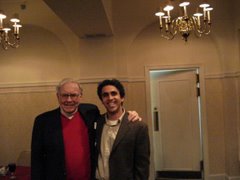The concept of value investing as the only type of investing is a profound statement and one I hang my hat on here at Gad Capital Management. For the first 15 years or so in his life, Buffett made his money buying cheap, low quality cigar butts that pocketed him 20% - 30% gains in a relatively short period of time. That beginning gave Buffett his name. What made his career was a entirely different approach that he has honed in on for nearly 50 years: buying quality businesses at slightly undervalued or fairly valued prices.
To most value investors, buying a fairly valued security seems contradictory to the value investing approach. On the contrary, I would opine that what gets many "value investors" in trouble is sticking to statistically cheap stocks and ignoring the value in quality stocks trading at reasonable valuations.
The ultimate key to value is, of course, price. But if you buy a statistically cheap stock without any value creating catalyst, you many find yourself waiting a very long-time for that value to be unlocked. On the other hand if you are able to buy a quality issue at a reasonable price, you may come to find a lot of value creation over the years that such an investment is held.
Indeed, one of the best types of a margin of safety is quality. Indeed, the man himself speaks exactly to that point. In Chapter 20 of The Intelligent Investors, Ben Graham suggests:
However, the risk of paying too high a price for good-quality stocks - while a real one - is not the chief hazard confronting the average buyer of securities. Observation over many years has taught us that the chief losses to investors come from the purchase of low-quality securities at times of favorable business conditions....These securities do not offer an adequate margin of safety in any admissible sense of the term. (emphasis added)
Indeed if you buy an excellent business trading at 90% of intrinsic value but that company can grow its future cash flows, then isn't intrinsic value going to increase over time, thus giving you a wider margin of safety? Isn't this the case with Apple (NASDAQ: AAPL), which out of great irony, has never traded at a nosebleed valuation over the past several years despite producing the type of growth rates that any tech company would dream for? In the company's most recent quarter, it generated $13 billion in net profit, almost the amount of income generated in all of fiscal 2010. Isn't a company with that growth potential and high quality trading at 20 times earnings a better value proposition than a single digit P/E, low book value stock that may suffer losses at the first sign of economic trouble?
I've learned this lesson the hard way with my personal example, Chipotle Mexican Grill (NYSE: CMG). If it's lunch or dinner time and there is a Chipotle with 15 miles, that is where I am going. And apparently so are hundreds of other people all throughout the day. Chipotle, by all measures, is a fantastic business in an industry that is not all that fantastic. Chipotle takes fine dining type food and sells it quickly and at a very attractive price. I have been the biggest advocate for this company to anyone I talk to. (Steve Els, if you happen to read this, I just want you to know that Sham Gad has probably turned on over 100 people to Chipotle who probably eat there twice a week.)
Yet what was glaringly obvious to me from a business perspective was not so obvious from an investment perspective because I anchored too much on numerical quality and not enough on qualitative attributes. So when the Great Recession gave me a chance to buy Chipotle at $130, or 20 times earnings, I stalled. Fast forward three years later and what Chipotle is earning now equates to about 12 times earnings that share price. (As a consolation, my hometown is getting its first Chipotle in 2012, which I hope will serve as a constant reminder of my error of commission.)
It is precisely this approach to investing that led Buffett to See's Candies, Coca-Cola, The Burlington Northern, and most recently, to committing $10 billion to IBM. When Buffett bought The Burlington Northern, esteemed value investors took him to task as paying too much for a capital intensive business. Now the consensus is that he bought the railroad for half of what it would sell for today.
Making investments casts a wide net. Special situation opportunities like my recent discussion on Premier Exhibitions (PRXI) doesn't fit the mold of quality per se, but it does pass the test of probability. After all, investing is nothing more than a probabilistic exercise. What quality does is skew the probability of a favorable outcome squarely on the side of the value oriented investor.


No comments:
Post a Comment